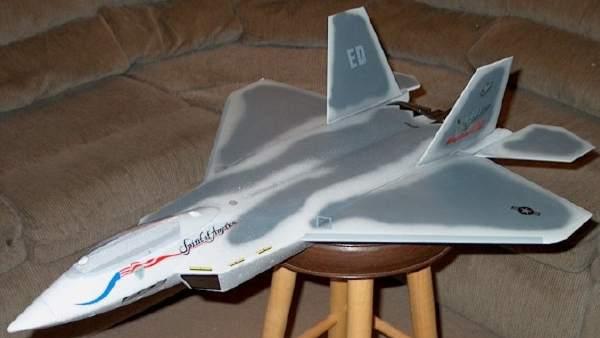
Brief:
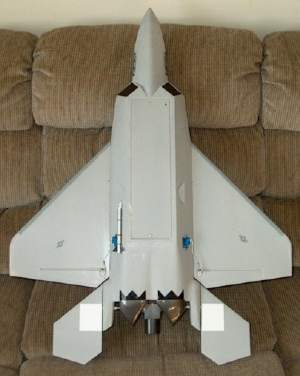 The F-22 Raptor is a Radio Controlled Electric Jet
Kit made by Wattage and normally flies on an electric motor with an 8-cell pack
and speed controller. Being a BIG R/C enthusiast, I purchased the kit for
flying, but decided to convert it to a R/C rocket glider for the field. I own
two WattAge kits to date and they both fly well. The manufacturer has marketed
excellent kits that are easily converted to some of the coolest looking R/C
Boost gliders you will ever find. An F-22 Raptor as a Rocket glider is, in my
opinion, the ultimate in the latest and greatest technology.
The F-22 Raptor is a Radio Controlled Electric Jet
Kit made by Wattage and normally flies on an electric motor with an 8-cell pack
and speed controller. Being a BIG R/C enthusiast, I purchased the kit for
flying, but decided to convert it to a R/C rocket glider for the field. I own
two WattAge kits to date and they both fly well. The manufacturer has marketed
excellent kits that are easily converted to some of the coolest looking R/C
Boost gliders you will ever find. An F-22 Raptor as a Rocket glider is, in my
opinion, the ultimate in the latest and greatest technology.
Modifications:
The mods I made to the kit are as follows; instead of permanently mounting the
electric motor plywood bulkhead plate, I made two duplicates of it. With three
plates in hand I was ready to go. They want you to mount the plate across the
back, but I wanted to make this jet so I could use both Electric power and
Rocket power, so I made the following changes.
I cut a recess in the bulkhead area of the jet where the plate would mount and made it 1/8" deep, which was the thickness of the ply plate. Next, I stacked all 3 plates and drilled 4 holes through them, 3/8" from each corner and installed/epoxied 2-56 "T" nuts into the master plate so the motor mount plates could be interchanged. The T nut holes were sealed with wax so epoxy would not ruin them, then I pushed 4 dimples in the styrofoam base at the T nut locations so the plate would sit flush in it's well. Then, I installed the original plate into the recess with 5 minute epoxy. Now I had a flush surface mount to interchange my two other motor mount plates.
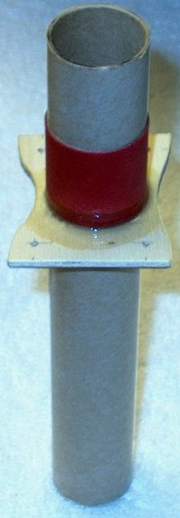 Each motor plate had 4 holes drilled
through it to match the T nut holes from the previously installed master plate.
I mounted the electric motor on one of them and installed it onto the master
plate with 2-56x34" bolts to check for fit. Next, I began working on the
Motor Mount for the rocket motor adapter.
Each motor plate had 4 holes drilled
through it to match the T nut holes from the previously installed master plate.
I mounted the electric motor on one of them and installed it onto the master
plate with 2-56x34" bolts to check for fit. Next, I began working on the
Motor Mount for the rocket motor adapter.
I used LOC 29mm motor mount tube to give me the option of upgrading motors if necessary. The tube is nice and sturdy and was cut to a length of 8" and epoxied into the hole I cut into the third mounting plate. The mount extends 2 1/4" beyond the mounting plate, so you can use this as reference if you do the mod. I originally had it at 2 1/2", but shortened it for CG purposes right before the final launch. I used two Estes couplers I had for larger body tubes and they fit right over the LOC motor mount tube. One was epoxied over the rear of the tube, flush with the plate and is 1 1/4" long. The "jet tailcone" plastic shroud you receive with the kit was cut to fit just over the motor mount tube and sit flush against this outer coupler.
A second coupler was cut to 1" long and left loose so I could mount the plate, install the plastic jet tailcone shroud , and use this outer coupler as a "wedge" against the back of the plastic tailcones. It was wrapped in dark gray stick-on Monokote to match the color and shine of the pre-painted jet tailcones. A 29mm to 24mm LOC Motor Mount Adapter was added so I had the option of using 24mm if necessary. I wrapped the end of the adapter with masking tape to add a 3/8" thick bottom lip so it would not shoot through the 29mm motor mount. I wrapped the tape with some of the Monokote to match color. Since there is no ejection charge, friction fitting is what was used for the adapter and installation of the actual motor. The LOC adapter came with just the right tension for fitting, but an installed 24mm RMS motor had to be taped for good fit. All ends of each tube and adapter were hit with CyA glue to stiffen them, then lightly sanded to remove rough edges.
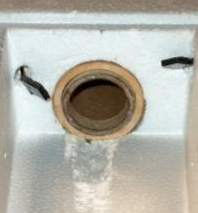 Next, I began sanding the hole through
the styrofoam in the back of the jet where the motor mount would reside. I used
a piece of broomstick, wrapped in sandpaper and enlarged the supplied hole so
the rocket motor mount tube would fit. The hole was already started as this is
where the electric motor wires run through to connect up inside the radio
compartment. A custom 1/8" ply centering ring was made for the 29mm Motor
mount and it had a 1/8" lip on it. This ring was epoxied into the forward
compartment and adds extra support to the top of the 29mm motor mount when
installed. I did not epoxy the 29mm mount to the ring, so I could remove it and
use the electric motor later. This completed the mods for the jet.
Next, I began sanding the hole through
the styrofoam in the back of the jet where the motor mount would reside. I used
a piece of broomstick, wrapped in sandpaper and enlarged the supplied hole so
the rocket motor mount tube would fit. The hole was already started as this is
where the electric motor wires run through to connect up inside the radio
compartment. A custom 1/8" ply centering ring was made for the 29mm Motor
mount and it had a 1/8" lip on it. This ring was epoxied into the forward
compartment and adds extra support to the top of the 29mm motor mount when
installed. I did not epoxy the 29mm mount to the ring, so I could remove it and
use the electric motor later. This completed the mods for the jet.
 One thing left to do...a launch lug. I
used two leftover tubes from HPR Aerotech ignitors for launch lug tubes. They
were cut to 4 1/2" long, the forward tips were tapered and both ends and
the inside were sealed with CyA to stiffen them. Now came the cool part; I
wrapped each one in light gray Monokote self stick wrap, added a couple stripes
in different colors, and cut some fins from .010 dark gray plastic strip I
bought at the hobby store. The tips of the tube were painted white and the
"fins" were epoxied on, then the entire lug was epoxied to the
fuselage. My goal, if you hadn't noticed, was to camouflage the launch lugs so
they looked like missiles, and it worked out well. I only use one lug during
launch, but added two to balance it out for looks.
One thing left to do...a launch lug. I
used two leftover tubes from HPR Aerotech ignitors for launch lug tubes. They
were cut to 4 1/2" long, the forward tips were tapered and both ends and
the inside were sealed with CyA to stiffen them. Now came the cool part; I
wrapped each one in light gray Monokote self stick wrap, added a couple stripes
in different colors, and cut some fins from .010 dark gray plastic strip I
bought at the hobby store. The tips of the tube were painted white and the
"fins" were epoxied on, then the entire lug was epoxied to the
fuselage. My goal, if you hadn't noticed, was to camouflage the launch lugs so
they looked like missiles, and it worked out well. I only use one lug during
launch, but added two to balance it out for looks.
Construction:
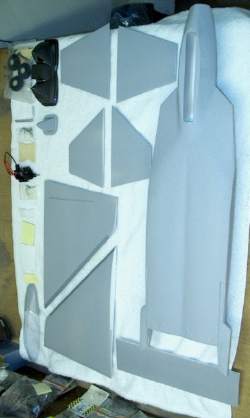 This review is going to be a bit
different, since the WattAge Raptor is an actual aircraft converted for Rocket
Assist. No body tubes or nosecones here, but what you do get when you open the
box is a complete styrofoam jet kit, minus radio, ESC (electronic speed
controller) and batteries. This is an ARF, Almost-Ready-to-Fly kit and only
requires wing, elevator and vertical stab attachment. Hats off to the
manufacturer for producing an easy to build (on an Estes scale, about a skill
level 2) and quick to assemble kit.
This review is going to be a bit
different, since the WattAge Raptor is an actual aircraft converted for Rocket
Assist. No body tubes or nosecones here, but what you do get when you open the
box is a complete styrofoam jet kit, minus radio, ESC (electronic speed
controller) and batteries. This is an ARF, Almost-Ready-to-Fly kit and only
requires wing, elevator and vertical stab attachment. Hats off to the
manufacturer for producing an easy to build (on an Estes scale, about a skill
level 2) and quick to assemble kit.
The ARF kit for the WattAge F-22 Raptor arrives in an attractive box. Inside, you find everything you need to assemble the jet, minus glue, ESC and radio. The wings are assembled first; 5 minute epoxy is used throughout the construction and alignment points are given all the way through the instruction manual, which is very well written. You can assemble the jet with or without the supplied landing gear. YES, it comes with landing gear and wheels for runway takeoff, but I opted to not use them in order to keep the weight down. It's your choice in the manual.
 Once the wings were assembled, you glue
on the vertical tails. Very simple to do, but I wanted to note that adding a
very small fillet to both sides of each vertical stab really makes the joint
strong. Next, you assemble the horizontal tails ( flying stabs). They are a bit
complex as these "flying stabs" pivot at their center on an aluminum
rod, which makes for a realistic look and control, just like the REAL F-22 Jet.
Once everything is glued, you cut out the cockpit glass and tail cone plastic
pieces and fit them. Finally the radio is installed. The plane was designed for
Elevon control, which means up and down/left and right turning is all done with
the rear horizontal flying stabs. Anyone familiar with R/C rocket gliders like
the HobbyLabs SR-71 knows what this is and as a matter of fact, you can use the
same radio, the HiTec 3-channel, which is made just for this purpose. I,
however, used an Ace MicroPro 8000 computer radio as I wanted to really tweak
in my settings! Being an R/C enthusiast for over 15 years has allowed me to
acquire all the equipment needed to get this bird in the air.
Once the wings were assembled, you glue
on the vertical tails. Very simple to do, but I wanted to note that adding a
very small fillet to both sides of each vertical stab really makes the joint
strong. Next, you assemble the horizontal tails ( flying stabs). They are a bit
complex as these "flying stabs" pivot at their center on an aluminum
rod, which makes for a realistic look and control, just like the REAL F-22 Jet.
Once everything is glued, you cut out the cockpit glass and tail cone plastic
pieces and fit them. Finally the radio is installed. The plane was designed for
Elevon control, which means up and down/left and right turning is all done with
the rear horizontal flying stabs. Anyone familiar with R/C rocket gliders like
the HobbyLabs SR-71 knows what this is and as a matter of fact, you can use the
same radio, the HiTec 3-channel, which is made just for this purpose. I,
however, used an Ace MicroPro 8000 computer radio as I wanted to really tweak
in my settings! Being an R/C enthusiast for over 15 years has allowed me to
acquire all the equipment needed to get this bird in the air.
The Flying Stabs (Elevators) received a slight modification. I cut two lengths of 1/8" wood dowel and inserted them inside the aluminum tube that pivots for elevator movement; this adds extra strength to the thin aluminum tubing, a trick I learned when building ducted fan R/C jets using Flying Stabs. These sticks were epoxied inside each tube, then the retainers were added to hold each Stab in place so they wouldn't back out of the bushings.
The servos were installed, but I deviated from the plan by custom installing Aileron servos for the wings. This gave me separate control over the Elevators (up and down) and the Ailerons (rotate left or right). I did install the electronic speed controller so I could fly it under electric power. The receiver was next and the antenna was routed forward into the battery compartment (cockpit area) and back again. A servo reverser had to be used on the Elevator flying stabs, so that was also installed.
Finishing:

Flight:
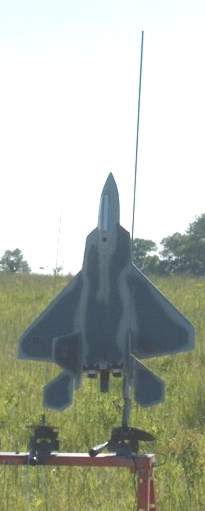 Well, the first flight did not go well. I took the
Raptor out of the car as it was going to go up first. I turned on the radio and
programmed all settings (at least I thought I did...Problem 1).
Well, the first flight did not go well. I took the
Raptor out of the car as it was going to go up first. I turned on the radio and
programmed all settings (at least I thought I did...Problem 1).
I did a range check and loaded up a F24W for it after it was weighed in at 16 oz exactly without motor. (Problem 2)
I had the rocket with it's bottom to the wind (Problem 3)
It launched and did about a 35' loop, right into the ground! I was stunned.
Well, I came to find out the settings I did on the radio didn't take and my throws were too much. Thank goodness I didn't use dual rates, as the control surfaces were turning in the wrong direction in that mode. So, instead of 3/4" throw, I was getting about 1 1/4" throw...making it much more sensitive and hard to control. I can usually do well with that though, as I feel I am a good pilot. The model balanced with the motor right about 1/4" behind CG, which was within range and would quickly move forward as the motor burned up. The F24 was a bad choice on my part. TOO much motor, but live and learn. Now, with throw too great, winds picking up, bottom to the wind instead of top (it spun around) and too much motor, you would think nothing else could go wrong, right??? WRONG...
When the Raptor launched, it decided to take the Aerotech Ignitor Clip, along with about 12" of Twin lead 14ga heavy wire!!! Yup folks, all that heavy weight just dragged behind the model and made it SUPER tail heavy and completely uncontrollable. Those are the problems you DON'T see. Funny thing is, I couldn't understand why it was so hard to control, until the next guy went to use the pad while I was picking up the pieces and asked "...where is my Aerotech Ignitor Clip?" I figured it 'whipped' the clip off as it made the bottom of the loop. Sure enough, it was about 15' behind the Raptor, in the grass. Lesson learned.
Repairs were easily made though as only the nose broke off. Styrofoam planes only require a little epoxy and paint to fix, so it was ready to go again. This time though, I decided to take it up on electric first to trim the plane out. I went to a local park, got the Raptor out on electric power, opened the hood of the car and started charging the 8-cell power pack with my HiTec charger. I flew the plane with the FULL 8 cell pack for Electric flying in it, as the speed controller acts as a voltage reducer for the receiver and I needed noseweight to make it stable for electric AND rocket power.
It was windy, I would say about 10mph winds and it was a cool day, around 55-60 degrees. I figured with the wind it shouldn't take much to launch and I was right. I held the MicroPro 8000 xmitter with my right hand, , gripped the F-22 with my left, moved the throttle to full with my chin and gave it a toss from a stand still.
It took to the skies great, climbing up and out! I didn't fly it over 50-100 feet above the ground, mainly to see it for better control as I didn't have a whole lot of room like at a flying field. It required no trim at all, one click of right Aileron probably but I didn't bother. Going upwind, it was a slow flier, managing maybe 20 mph, but downwind it cooked, at least 60mph. I was having so much fun I couldn't stand it!!! It turned well and even did rolls, which required a bit more up when inverted and that surprised me.
The landing was a cinch, slightly nose down on deadstick, the flare, and it landed at about 5mph. It was sooooo much fun I picked it up and tossed it again real quick, took it once around the park and landed it again. back on the charger it went.
With three good electric flights under my belt, it was ready for a rocket motor. For more performance, it still would require a bit more Aileron, but I guessed at the settings as it was designed for Elevons. Elevator was set at the full 3/4" throw and responded well.
Saturday, May 26, 2002 it had it's debut on the rod. Our local NAR club Prez, Mark Fisher, was kind enough to load up one of his 24mm plugged E12 loads ( MUCH gentler motor) and we placed it on the pad. We actually had to lean the outer wing on the 1/8" launch rod next to it, so the breeze wouldn't spin it. Rod angle was at 20 degrees and when the button was pushed, it took of the rod like a dream!!! I had to give it a lot of down elevator on launch but it went straight up to about 500 feet.
Recovery:
I nosed it over, then turned into the wind, keeping it nose down so it wouldn't
stall. It did a couple unexpected rolls (may have been stall) on me but landed
upright and safely on the ground, with little damage. The E12 is the PERFECT
motor for this bird! What a day..Big thanks go to Mark for supplying the
reload.
Summary:
The Wattage F-22 Raptor was an exotic experiment in R/C rocket glider flying,
to say the least! It took a few attempts to work out the bugs, but now that it
has flown, all the effort has made it worth while. I still need to check the
receiver for antenna damage as it should not have rolled like it did, but that
will be done soon as I will shake down the entire radio system. I considered my
last flight as it's best, with only the tip of the nose slightly damaged but
easily repaired. All of the bugs have been worked out on this bird though, and
I have included measurements for the conversion, so yours can be successful
right from the start. The E12 is perfect for this aircraft, and F12 would even
be better with more smoke and longer duration, so you could actually fly it
under power.
I have to say, when you show up at a field with an F-22 Raptor jet, you get a LOT of attention! This is the latest in U.S.A.F. technology and the WattAge kit is a perfect duplicate of the real Jet. Moreover, to actually see it fly under rocket power is unbelievable. Thanks go to Ken Parker, my R/C rocket glider mentor and good friend for his assistance; he has one for himself, but has not had a chance to build it yet. With all the kinks worked out though, I am sure his will be in the air soon. For you R/C Rocket Glider enthusiasts, if you want to STUN them at the field, you just HAVE to get one of these! The WattAge F-22 Raptor is by far the best and coolest looking R/C rocket glider conversion you will ever fly!
Sponsored Ads
 |
 |











